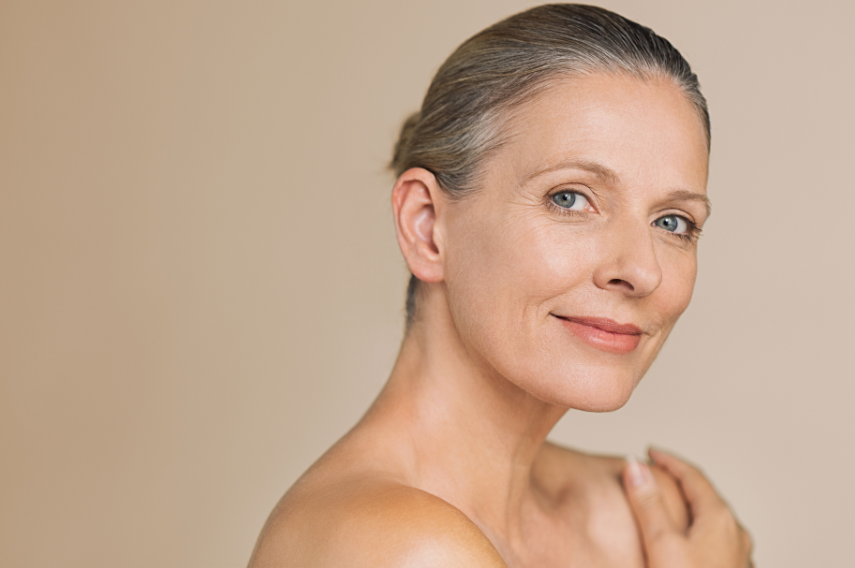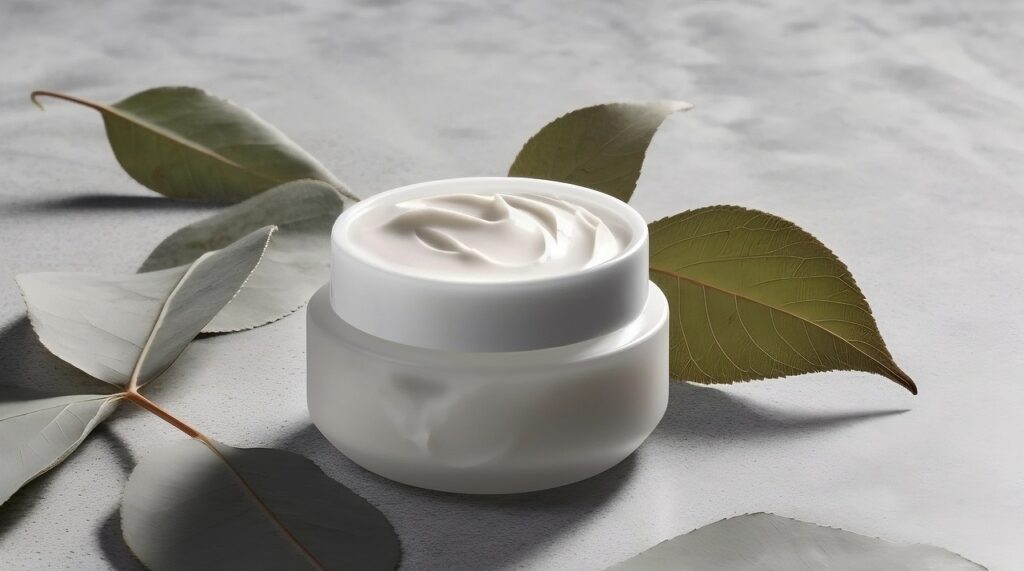A scary fact. We can lose up to 30% of our collagen and elastin during our perimenopausal years.
Enter estriol 0.3% cream—a gentle yet powerful solution that’s making waves in the world of skincare. Backed by science and loved by dermatologists, this cream is here to help you embrace your natural glow, even when estrogen levels are on the decline.
Introduction to Menopause and Perimenopause:
- Menopause: Defined as the permanent cessation of menstruation, typically occurring between 45-55 years of age.
- Perimenopause: The transitional period preceding menopause, characterised by fluctuating estrogen levels.
Dermatological Implications:
- Estrogen Decline: Leads to diminished collagen synthesis, reduced skin thickness, and decreased skin hydration.
- Clinical Symptoms: Increased wrinkle formation, loss of skin elasticity, and exacerbated dryness.
What is Estriol?
Estriol is a type of estrogen hormone, often referred to as the “gentle” estrogen. For menopausal skin, it helps boost hydration, improve elasticity, and reduce dryness by supporting skin’s natural moisture barrier. Think of estriol as a soothing ally, giving your skin a little extra TLC during the menopause transition!
- Collagen Production: Estrogens, particularly estradiol, are critical for collagen biosynthesis, which is essential for maintaining skin structure.
- Hydration and Barrier Function: Estrogens enhance the skin’s barrier function and promote hydration by influencing the production of natural moisturising factors.
Decline During Menopause:
- Reduced Estrogen Levels: Leads to a decline in skin structural integrity and moisture retention, resulting in clinical signs of skin aging.
Estriol: A Targeted Estrogen for Skin Care
- Estriol (E3): The weakest of the three main estrogens (estradiol, estrone, and estriol), with a distinct safety profile due to its limited systemic absorption.
Mechanism of Action on Skin:
- Receptor Binding: Estriol selectively binds to estrogen receptors (ER-β) in the skin, modulating gene expression related to collagen synthesis and skin repair.
- Localised Effects: Minimal systemic activity, making it a safer option for topical application on the face.
Give me the science!
Clinical Efficacy of Estriol 0.3% Cream:
- Skin Elasticity and Thickness: Clinical trials demonstrate that estriol 0.3% cream significantly improves skin elasticity and thickness by upregulating collagen production .
- Hydration and Moisture Retention: Estriol enhances the skin’s ability to retain moisture, reducing the severity of dryness and improving overall skin texture.
- Wrinkle Reduction: Studies indicate a marked decrease in wrinkle depth and improved skin surface smoothness with regular use of estriol 0.3% cream.
Is it for me?
Here’s who can benefit:
-
Women going through menopause: As estrogen levels decline, estriol can help restore skin hydration and elasticity.
-
Women experiencing dry, thinning skin: Ideal for those whose skin has become drier or less supple with age.
-
Women with sensitive skin: Estriol is a milder form of estrogen, making it gentler on delicate skin.
-
Women looking for a natural skincare solution: Especially those wanting to avoid stronger synthetic hormones.
-
Women with hormonal imbalances: Helpful for those needing a gentle hormone boost for skin health during menopause.
Comparative Analysis: Estriol vs. Estradiol
- Estriol vs. Estradiol: While both estrogens positively impact skin aging parameters, estriol is preferred for its lower risk of systemic effects.
Safety Profile:
- Lower Systemic Absorption: Estriol’s weaker binding affinity to estrogen receptors results in lower systemic absorption, reducing the risk of adverse effects commonly associated with estradiol.
Application and Usage Guidelines:
Recommended Use:
- Indication: Suitable for postmenopausal women experiencing skin aging symptoms, including dryness, reduced elasticity, and wrinkles.
- Application Protocol: Apply a small amount of estriol 0.3% cream to the face daily, with emphasis on areas prone to wrinkling (e.g., periorbital and perioral regions).
Monitoring and Safety:
- Dermatological Response: Regular monitoring for signs of irritation or hypersensitivity is recommended.
- Clinical Consultation: Prior to initiation, a consultation with a healthcare provider is advised, particularly for individuals with a history of estrogen-sensitive conditions.
Clinical Relevance:
- Targeted Skin Rejuvenation: Estriol 0.3% cream is a scientifically proven solution for menopause-related skin changes. It effectively improves skin elasticity, thickness, and hydration.
- Safety and Efficacy: The cream’s favorable safety profile, combined with its targeted action on skin estrogen receptors, positions it as a viable option for facial skin care in postmenopausal women.
What is Estriol?
Estriol is a naturally occurring estrogen hormone produced primarily during pregnancy and is one of the three main estrogens in the female body, alongside estradiol and estrone. Compounded estriol is commonly used in hormone replacement therapy and is recognised for its potential skin revitalisation effects when applied topically.
What is Compounded Estriol 0.3% Cream?
Compounded estriol cream is a personalised formulation that contains 0.3% estriol, tailored by a pharmacist to meet specific patient needs. This cream is often prescribed to address skin concerns associated with hormonal changes due to aging.
How Does Estriol Cream Work for Anti-Aging?
Estriol exerts its effects by binding to estrogen receptors in the skin, leading to several beneficial outcomes:
- Collagen Stimulation : Estrogen plays a crucial role in collagen synthesis. Estriol can stimulate fibroblasts (the cells responsible for collagen production) to enhance skin thickness and elasticity.
- Improved Hydration : Estriol promotes the retention of moisture in the skin by supporting a healthy skin barrier. This can help reduce dryness, making the skin look plumper and more youthful.
- Inhibition of Aging Factors : Estriol can help inhibit the activity of enzymes (like matrix metalloproteinases) that break down collagen, further supporting skin integrity and reducing signs of aging.
- Increased Cell Turnover : By promoting healthy skin cell turnover, estriol may aid in the reduction of fine lines and improve the overall texture of the skin.
How do I use Estriol 0.3% cream?
Follow your healthcare provider’s instructions for application. Usually, the cream is applied to clean, dry skin once or twice a day. It’s essential to use it consistently for optimal results.
Who should use Estriol cream for anti-aging?
Individuals experiencing hormonal changes associated with aging, such as decreased skin elasticity and hydration, may benefit from this cream. However, a consultation with a healthcare provider is essential to determine if it is appropriate for your specific situation.
When will I see results?
Many users report improvements in skin texture and hydration within a few weeks, while more significant benefits, such as increased elasticity and reduced fine lines, may take a few months to become noticeable.
Are there any side effects?
Some potential side effects may include localised skin irritation, redness, or itching. Although rare, systemic effects such as mood changes or menstrual irregularities can occur. Always discuss any adverse reactions with your healthcare provider.
Can I combine this cream with other skincare products?
Yes, estriol cream can generally be combined with other skincare products, but it’s wise to check with your healthcare provider. Some ingredients may have varying interactions, affecting efficacy.
Is it safe for long-term use?
The safety of long-term use of estriol cream should be assessed by your healthcare provider, who can help balance the treatment’s benefits with any potential risks based on your health history.
Can anyone use Estriol cream?
Not everyone should use estriol cream. Individuals with certain medical conditions, such as estrogen-sensitive cancers, may need to avoid it. Always disclose your medical history to your healthcare provider to evaluate the best treatment options.
Is Estriol cream available in Australia?
By tailoring the ingredients, concentrations, and delivery methods, compounding pharmacies can address specific concerns such as dryness, elasticity, or hormonal balance that are often overlooked in commercial products.
This personalised approach ensures that patients receive a formulation designed for their unique skin type and aging concerns.
Ready to transform your skincare routine? Book a skincare consultation with us today!
Follow us on Instagram for the latest skincare tips and trends!
Simply have a question? Contact us now.
References:
- Lobo, R. A. (2007). “Hormone Replacement Therapy: Current Recommendations.” Menopause: The Journal of The North American Menopause Society , 14(4), 682-689. This article discusses the role of hormone replacement therapy in treating menopausal symptoms, including skin-related changes.
- Rabe, T., & Wehling, M. (2015). “Estrogen and the Skin: A Review of the Biological Mechanisms.” European Journal of Obstetrics & Gynecology and Reproductive Biology , 185, 97-102. This paper reviews the effects of estrogen on the skin, including how it influences collagen synthesis and skin hydration.
- Elias, P. M., & Fritsch, C. (2014). “The Role of the Stratum Corneum in the Skin’s Barrier Function and Cosmeceutical Interventions.” Journal of Cosmetic Dermatology , 13(1), 24-34. This article discusses how skin hydration can be improved through various interventions, including the application of topical estrogens.
- Weitz, J. & Klem, M. (2018). “The Role of Estrogens in the Aging Process of Skin.” Menopause International , 24(3), 121-125. This article summarises how estrogens affect skin aging and discusses topical estrogen therapies.

Lane Khin, the compounding pharmacist of My Skin Pharmacy, brings a wealth of knowledge from the worlds of pharmacy and dermatology to the table. With degrees in Pharmacy and Applied Science from QUT, Lane combines a deep understanding of compounding and skincare with a friendly, accessible approach. Through My Skin Magazine, Lane shares her expertise, offering readers practical advice and insights into personalised skincare solutions. Lane has a real passion for helping others achieve their best skin.


